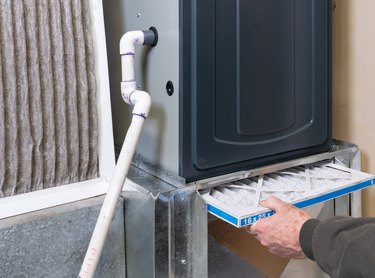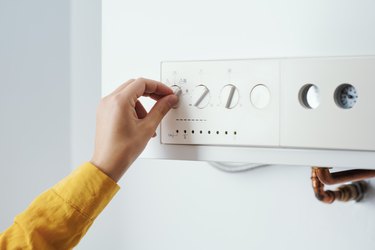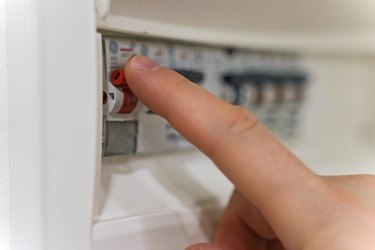
Your furnace not turning on is a problem that affects both your comfort and well-being, but if you are among those who have experienced record cold temperatures in recent years, you may also consider it a survival issue. While troubleshooting a malfunctioning HVAC system is typically a job for an HVAC technician, homeowners can DIY a number of common furnace problems themselves and get the heat back on without a service call.
Problems that affect furnace performance can just as easily originate in the thermostat as well as in the furnace itself, so the thermostat is the best place to begin your furnace troubleshooting. This is also the safest place to start troubleshooting because the low voltage in the thermostat is nonhazardous. If the problem isn't with the thermostat and your troubleshooting efforts lead you to an examination of the furnace control board or the furnace itself, you need to remember to turn off the power when you're working, and you should proceed only if you have a basic understanding of how a furnace works. Otherwise, it's time for a service call to a professional.
Video of the Day
Reasons for a Furnace Not Turning On
Whether you have a gas, oil, or electric furnace, it gets its instructions from the thermostat, so the first thing to check is whether the thermostat has power. If it does and it's working properly, it sends electrical signals to a transformer that relays them to the furnace control board. The control board then distributes the signals to the equipment inside the furnace itself.
The first component to receive power is the blower, which is a big fan typically housed in a separate housing next to the furnace called the air handler. If it's functioning normally and turns on, there's usually a delay before the furnace comes on. If you have a gas furnace, the ignitor energizes, and there's another delay before the gas valve opens and the burner starts. If you have an oil furnace, the fuel pump starts spraying oil as soon as the electronic ignitor begins firing. If you have an electric furnace, the electric heating element energizes, and if you have a heat pump, the compressor starts.
While a furnace can malfunction for purely mechanical reasons, such as a low oil or gas supply or a blockage in the gas line, many stoppages are caused by an interruption of the electrical signal from the thermostat to the furnace equipment. Furnaces have a number of safety switches to prevent overheating, explosions from a gas leak, and other accidents, and if one of these is the culprit, you can usually reset it. You can prevent many such interruptions with furnace maintenance, which includes a tune-up and cleaning or replacing every air filter in the system regularly.
Here's a list of reasons your furnace won't start and some troubleshooting tips.
1. Thermostat Has No Power
If power isn't coming into the thermostat from the system transformer, the thermostat can't send signals to the HVAC system. The problem could simply be a tripped circuit breaker, so open the electrical panel and look for one. If a breaker has tripped, you'll probably see an orange warning flag, and all you have to do is flip it completely off (toward the outside of the panel) and then on (toward the center of the panel). You should also check the furnace switch, which looks like a light switch mounted on the side of the furnace or air handler. If it's off, turn it on.
If the thermostat still doesn't work, try changing the batteries. If your thermostat doesn't have batteries, it has a common wire (C-wire) that supplies power to it from the transformer, and you can use this wire to test for voltage using a multimeter set to measure voltage.
- Remove the thermostat cover or face to expose the wires.
- Set a multimeter to test voltage in the 24-volt range.
- Touch one lead to the red power wire connected to the R or RH terminal and the other lead to the blue or black wire connected to the C terminal. You should get a reading between 22 and 28 volts. If not, check the wire connections at the thermostat and inside the system control board to make sure they are tight. If they are, you may need a new transformer.
2. The Thermostat Settings Are Wrong

Check the fan setting on the thermostat. If it's in the ON position, which makes the blower come on and blow cold air even if the furnace is off, set it to AUTO. Make sure the mode selector is set to HEAT and not COOL.
If you have a programmable thermostat, adjust the temperature setting value well above room temperature and wait for the blower and furnace to come on. If nothing happens, your thermostat may be set to permanently hold a lower temperature. Consult your manual for the procedure for disabling the permanent hold feature.
3. A Safety Switch Is Engaged or Malfunctioning
The door to the furnace or the air handler may have a switch that cuts power to the system if the door is open. This switch is a safety feature, and all you may have to do is close the door. Occasionally, this switch may malfunction, so if the system stays off after you close the door, do a simple continuity test on the switch to make sure it's working.
- Turn off power to the furnace.
- Disconnect the switch wires to isolate the switch.
- Set a multimeter to measure resistance in ohms. You can also use a continuity tester.
- Touch one lead to one of the switch terminals and the other lead to the other terminal. Push on the switch to open the circuit. The meter should read zero, and if you're using a continuity tester, the light should come on. If you don't have continuity, you need to replace the switch.
4. The Limit Switch Has Tripped

Another safety feature you find on most furnaces is a high limit switch that shuts off the system if the internal temperature gets too high. This switch may have a reset button, but if it doesn't, you can usually reset it by turning off the furnace, leaving it off for 10 to 30 seconds, and turning it back on.
If this switch trips repeatedly, the problem may be insufficient airflow caused by a dirty air filter, so clean and replace the furnace filter. There may also be a dust buildup or some other blockage in the air ducts that needs to be cleared. If it continues to trip, this could indicate a serious furnace issue, such as a cracked heat exchanger, which could result in a carbon monoxide or gas leak. You should call a professional furnace repair service.
5. The Condensate Drainage Tube Is Blocked

If you have a high-efficiency natural gas or propane furnace, which is one with an annual fuel utilization efficiency (AFUE) of 90 or more, it will have plastic — not metal — vent pipes, and it also has a drain pan to collect the condensation it produces in its secondary heat exchanger. This pan drains outside through a plastic tube, and if this tube gets blocked and water can't drain, a float in the drain pan shuts off the system until you clear the blockage.
The easiest way to do this is to locate the tube opening outside, wrap a vacuum hose around it, seal it with duct tape, and use a wet/dry vacuum to suck out the blockage.
6. The Flame Sensor Is Dirty
Your gas furnace has a flame sensor unless it's old enough to have a pilot light, which is unlikely since that type of furnace is largely obsolete. The furnace flame sensor works much like the thermocouple in an older furnace with a pilot: It generates an electrical signal when immersed in flames to keep the gas valve open and gas flowing to the burners. If the furnace flame sensor gets coated with soot to the point at which it can't detect flames, the furnace will cycle on and cut off again as soon as the burners light. The solution for this problem is to clean the flame sensor.
- Consult your manual for the location of the flame sensor. It's usually mounted on the side of the combustion chamber and held by a single screw.
- Turn off the furnace power.
- Unscrew the flame sensor and pull it out of the combustion chamber. The part you grasp is usually encased in porcelain, but the actual sensor is a straight or L-shaped metal rod.
- Clean the rod by rubbing it down with a mildly abrasive material, such as a kitchen scrubber. Some pros like to use a dollar bill for this. Don't use sandpaper because it will make deep scratches that collect soot.
- Mount the flame sensor back onto the combustion chamber and drive the screw to hold it.
- Turn the furnace back on, turn up the thermostat, and make sure the furnace comes on and stays on.
7. There Is a Control Board Problem

Sometimes, the cause of a furnace not coming on is a faulty relay or safety switch that's beyond a homeowner's ability to diagnose. For example, the blower motor might not come on before the furnace starts because it has a safety mechanism that prevents it from operating when the furnace is cold. A heating system with an oil furnace usually has an emergency switch that turns it off in case the oil tank is empty or the oil line is blocked. The sensor that controls this switch can sometimes fail to detect the fact that the flame is actually burning and that the furnace is blowing warm air, and it can trigger a shutdown. Diagnosing and repairing problems like these is a job for an HVAC pro.
Troubleshooting Why a Furnace Won't Turn On
Problem | Solution |
|---|---|
No power to thermostat | Reset breaker; replace batteries; check voltage at thermostat |
Wrong thermostat settings | Consult manual and reset thermostat |
Safety switch is engaged | Close doors to air handler and furnace |
Limit switch has tripped | Turn off furnace and turn it back on after 10 to 30 seconds |
Condensate tube is blocked | Clear the blockage with a wet/dry vacuum |
Flame sensor is dirty | Remove the flame sensor, clean the rod with a kitchen scrubbie, and replace the sensor |
Bug in the control board | Call an HVAC technician |